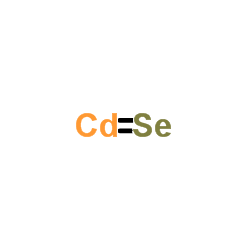cadmium selenide

cadmium selenide structure
|
Common Name | cadmium selenide | ||
|---|---|---|---|---|
| CAS Number | 1306-24-7 | Molecular Weight | 191.371 | |
| Density | 5.81 | Boiling Point | N/A | |
| Molecular Formula | CdSe | Melting Point | 1350ºC | |
| MSDS | Chinese USA | Flash Point | 39.2 °F | |
| Symbol |




GHS02, GHS07, GHS08, GHS09 |
Signal Word | Danger | |
|
Improved thermal cycling durability and PCR compatibility of polymer coated quantum dot.
Nanotechnology 24(35) , 355504, (2013) Quantum dots have experienced rapid development in imaging, labeling and sensing in medicine and life science. To be suitable for polymerase chain reaction (PCR) assay, we have tested QD thermal cycling durability and compatibility, which have not been addres... |
|
|
Optical properties of water soluble CdSe quantum dots modified by a novel biopolymer based on sodium alginate.
Spectrochim. Acta. A. Mol. Biomol. Spectrosc. 114 , 622-6, (2013) Water soluble CdSe quantum dots (QDs) were modified using a novel biopolymer based on the graft copolymerization of poly (acrylic acid) as a monomer onto sodium alginate as a backbone at room temperature. The obtained CdSe QDs were characterized by Fourier tr... |
|
|
Linseed oil based nanocapsules as delivery system for hydrophobic quantum dots
Colloids Surf. B Biointerfaces 110 , 1-7, (2013) In the present work, the CdSe/ZnS hydrophobic quantum dots were embedded within the polyelectrolyte nanocapsules. The core of the capsules, which consists of a mixture of the linseed oil with chloroform, was prepared using the spontaneous emulsification techn... |
|
|
The interface effect on the band offset of semiconductor nanocrystals with type-I core-shell structure.
Phys. Chem. Chem. Phys. 15(15) , 5472-6, (2013) In order to pursue the interface effect on the band offset of the semiconductor nanocrystals with the type-I core-shell structure, we have established a theoretical model to elucidate the underlying mechanism based on the atomic-bond-relaxation consideration ... |
|
|
Nonlinear optical spectra of intersubband transitions in a CdSe/ZnS/CdSe/SiO2 spherical quantum dot.
J. Nanosci. Nanotechnol. 12(11) , 8528-36, (2012) In this paper the electronic spectra and optical properties of one-electron spherical quantum dot (QD) are presented. QD is composed of CdSe core surrounded by ZnS shell (barrier) CdSe shell and finally by medium of very high potential barrier (SiO2) compared... |
|
|
The interactions between CdSe quantum dots and yeast Saccharomyces cerevisiae: adhesion of quantum dots to the cell surface and the protection effect of ZnS shell.
Chemosphere 112 , 92-9, (2014) The interactions between quantum dots (QDs) and biological systems have attracted increasing attention due to concerns on possible toxicity of the nanoscale materials. The biological effects of CdSe QDs and CdSe/ZnS QDs with nearly identical hydrodynamic size... |
|
|
Genotoxicity of intraperitoneal injection of lipoamphiphile CdSe/ZnS quantum dots in rats.
Mutat. Res. 758(1-2) , 48-55, (2013) The main objective of the present in vivo rat study was to determine the genotoxicity of lipoamphiphile-coated CdSe/ZnS Quantum Dots (QDs), in several organs (brain, liver, kidneys, lungs and testicles). The second objective was to establish the correlations ... |
|
|
Fabrication of SiO2 beads with high concentrated hydrophobic CdSe/Cd(x)Zn(1-x)S quantum dots using functional alkoxides.
J. Nanosci. Nanotechnol. 13(4) , 2993-8, (2013) A two-step approach including the assembly of QDs and subsequent Stöber synthesis has been developed to encapsulate hydrophobic CdSe/Cd(x)Zn(1-x)S core/shell QDs into SiO2 beads. TEM observation shows that the core/shell QDs have high concentration in the SiO... |
|
|
Lung toxicity and biodistribution of Cd/Se-ZnS quantum dots with different surface functional groups after pulmonary exposure in rats.
Part. Fibre Toxicol. 10 , 5, (2013) The potential use of quantum dots (QD) in biomedical applications, as well as in other systems that take advantage of their unique physiochemical properties, has led to concern regarding their toxicity, potential systemic distribution, and biopersistence. In ... |
|
|
Quantum dot-related genotoxicity perturbation can be attenuated by PEG encapsulation.
Mutat. Res. 753(1) , 54-64, (2013) Nanomaterial-biosystem interaction is emerging as a major concern hindering wide adoption of nanomaterials. Using quantum dots (Qdots) of different sizes (Qdot-440nm and Qdot-680nm) as a model system, we studied the effects of polyethylene glycol (PEG) thin-l... |